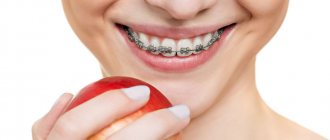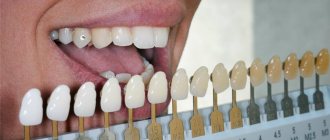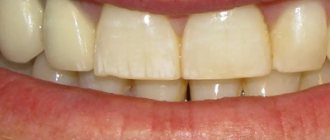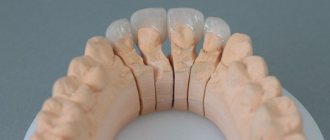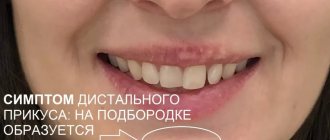08/17/2020 Veneers or braces?
Braces are the most popular design for correcting uneven teeth.
They are plates made of metal, plastic, ceramic or artificial sapphire, which are connected by a metal arc. Under the pressure of the arch, the teeth move into the correct places, and the bite is corrected. However, there is another method of correcting the bite - masking defects in the front teeth using thin ceramic plates - veneers.
Veneer installation
Let's look at both of these methods and find out in which cases it is worth installing braces, and in which cases - veneers.
Efficiency
Braces
Braces are still relevant precisely because of their effectiveness - metal structures can cope with almost any malocclusion. They cannot cope with only the most serious ones, which require surgical treatment.
Braces are effective for open bites, forward or backward displacement of the lower jaw, crowded teeth, and most other problems.
This applies specifically to metal braces. Braces made of ceramic, plastic or sapphire cannot cope with some anomalies - they are too fragile to put a high load on them.
Veneers
Veneers are designed primarily to create a whiter smile, so their functionality is much lower. They do not correct anything, but only mask defects, and exclusively in the area of the front teeth: incisors, canines and first premolars.
With the help of veneers, you can close the gaps between the teeth, lengthen the crowns a little and hide small irregularities. Veneers will not help with open, mesial, distal or deep bites.
Before and after braces
Before and after veneers
In case of serious malocclusion, it is necessary to install braces. Small gaps between teeth and abnormalities in the smile area can be closed with veneers.
Is it possible to straighten 1-2 teeth without braces?
Yes, you can, with the help of aligners. Aligners are a series of clear polycarbonate trays made using 3D scanning, virtual modeling and 3D printing technology that consistently straighten teeth. Aligners have many advantages over braces, but, unfortunately, they are still more expensive (sometimes very significantly) than classic braces. In addition, this method is well suited for correcting mild to moderate malocclusions. In difficult cases, the aligners may either fail to cope with the task at all, or the treatment will last for years and many tens, or even hundreds, of trays.
Aesthetics
Braces
Classic metal braces are noticeable on the teeth. Nowadays they are made smaller than before, but they are still visible when smiling and talking, and this cannot be avoided. For greater aesthetics, patients install braces made of plastic, ceramic or artificial sapphire, but they are still noticeable due to the metal arch and not a perfect match to the enamel. So in terms of aesthetics, braces definitely lose.
There are completely aesthetic lingual braces that are placed on the back surface of the teeth. They are absolutely invisible, but expensive and inconvenient, and also do not cope with all malocclusions.
Lingual braces
Veneers
Veneers are not just aesthetic - they create the aesthetics of a smile. Ceramic plates mask not only uneven teeth, but also stains on the enamel, yellowed teeth, small chips and cracks. They make teeth perfectly white, creating that very popular “Hollywood” smile, which cannot be achieved with any whitening. Veneers can restore front teeth after chipping, trauma, or decay due to caries, as well as hide tetracycline teeth and enamel damage due to fluorosis.
Before and after installation of veneers
Braces are generally noticeable and unaesthetic, but veneers make your smile perfect.
When are veneers needed?
Veneers are thin ceramic overlays that mask aesthetic defects in teeth. They are glued to the front surface and cutting edge, usually after first removing a small layer of enamel. This is necessary to compensate for the thickness of the restoration and not make the teeth too massive.
Veneers eliminate the following disadvantages:
- chips, cracks, grooves, worn edges;
- irregular tooth shape;
- uneven color, dull or dark color, spots;
- pigmentation that chemical bleaching cannot cope with;
- slight protrusion or rotation of the tooth around its axis;
- enlarged spaces, diastemas.
Ceramic onlays make the smile ideal, but in cases where the patient does not have pronounced bite defects. It must be remembered that veneers do not move teeth, do not affect their position in any way, they only hide visual imperfections. But in just 2-4 sessions you can solve several aesthetic problems at once.
Comfortable to wear
Braces
Unfortunately, wearing any braces is quite inconvenient. First you need to get used to them - the first two weeks, pressure on the teeth causes pain and impairs diction. Then, during treatment, you need to limit your diet - do not eat too viscous and hard foods: nuts, carrots, seeds. Cleaning them is also not easy - you need to clean the space around the braces and under the arches with special brushes and brushes.
Brushes for cleaning teeth
In addition, sometimes braces scratch the gums and mucous membranes of the cheeks (and lingual braces scratch the tongue). Of course, the pain can be eliminated with painkillers, diction will quickly be restored, and the mucous membrane is protected by gluing wax to the protruding parts of the braces, so all problems can be solved, but it is still quite inconvenient. However, patients note that new compact braces made of metal, ceramic or sapphire quickly become “familiar”, and after a month they do not cause any particular inconvenience (except for the need for lengthy cleaning).
Veneers
Veneers are glued to natural teeth so that they become an inseparable part of them. They do not spoil diction and usually do not cause pain or discomfort - only in the first couple of weeks the teeth sometimes ache under the veneers, but this is the consequence of grinding the enamel. Veneers do not require special cleaning and do not require any special dietary restrictions. They can crack if you bite through hard objects, but this also applies to natural teeth, so in general everything remains as is.
In terms of wearing comfort, veneers are significantly ahead of braces.
Myofunctional correction
Speech therapist-myofunctional therapist T.B. Zukor conducted an analysis of the functioning of the facial muscles. There was a noticeable imbalance in muscle function. Normalization of muscle tone is necessary, since, firstly, the retainers will have to be removed for about a month to carry out dental restoration, and secondly, after the completion of dental restoration, the issue of maintaining stable results of orthodontic treatment (which was completed in 2022) must be resolved, and here Retainers do not always cope with the task of holding teeth in place (see example of the appearance of a gap between teeth even with a retainer).
Myofunctional exercises were prescribed, which the patient performed before removing the retainer (the correction was carried out in parallel with dental treatment so that the patient did not waste time).
Contraindications
Braces
There are practically no contraindications to braces. They cannot be placed in case of serious diseases of the oral cavity, as well as in case of mental disorders, due to which the patient cannot properly care for his teeth or is capable of breaking the structure. But in general, braces are available for almost any situation.
Veneers
There are several contraindications to installing veneers. They should not be installed if too much stress is placed on the front teeth. This happens in the absence of sixes or sevens, or due to the habit of gnawing hard objects (nails, pens, seeds). Also, veneers cannot be placed if most of the front tooth was once restored with a filling, that is, it is severely damaged. In case of severe malocclusion, veneers cannot be installed either, since they cannot be placed evenly, and there is no point in installing them crookedly.
Veneers are also contraindicated for those who engage in boxing and other contact sports - they can easily crack. In case of bruxism and mental illness, it is also better not to use them.
Veneers have many more contraindications than braces.
Complex aesthetics with braces and veneers
To achieve an ideal healthy smile and maintain it for many years, comprehensive treatment using orthodontic and orthopedic structures is recommended.
Veneers and crowns should not be placed if there is severe crowding or an overbite. If the patient has an incorrect bite, then even the most beautiful and high-quality restorations will not be durable - they will chip due to uneven load distribution and improper closure.
Also, there is a risk that restorations on uneven teeth will look disproportionate, because anatomically correct onlays will not be placed in the original situation.
Before prosthetics, we recommend that your bite be corrected so that the orthopedic work is truly aesthetic and durable.
Possible complications
Braces
Braces can cause the following complications:
- Pain and discomfort immediately after braces are installed.
- Damage and inflammation of the mucous membrane due to injury from protruding parts of the structure.
- Plaque and tartar due to insufficient cleaning. May lead to gum inflammation.
- Caries due to insufficient cleaning.
- Stains on the enamel after removing braces. They appear if the braces were not glued tightly enough and plaque got under them.
- Increased sensitivity of teeth after removal of the structure.
All these complications can be avoided if you visit the dentist with any problems and brush your teeth thoroughly.
Veneers
Usually there are no problems after installing veneers. To install them, you need to grind down the enamel, so the teeth may ache a little for the first couple of days, but this goes away quickly. There are no other complications.
Veneers are not only more comfortable to wear, but also safer, since there are no problems with them.
Preparing the oral cavity for installation of braces
The presence of fixed dentures in the oral cavity is not a contraindication to orthodontic therapy. To avoid other troubles, the oral cavity must be carefully prepared:
- All dental diseases must be excluded. Caries and other ailments must first be healed.
- You need to have your teeth professionally cleaned to remove surface plaque and hard deposits.
- Follow hygiene procedures carefully. In addition to the brush and paste, it is also worth purchasing additional units, for example, a brush for braces and an irrigator. This will allow you to clean plaque even in hard-to-reach places.
Installation age
Braces
Braces can be installed after the age of 12, when all baby teeth have fallen out. To correct the bite of children under 12, plates and removable mouth guards are used. There is no upper threshold - braces are effective in correcting bites in adults as well. The treatment period in this case increases from six months to 1–2 years.
Braces for a child
Veneers
Veneers are permanent, so they can only be placed after the age of 18–20, when the jaw stops growing. If you place them earlier, the teeth may move a little further apart, and the aesthetic effect of the veneers will disappear. There is no upper limit either.
Braces can be installed in childhood, veneers are only suitable for adults.
Why is orthodontic treatment so expensive?
Modern orthodontic treatment has a fairly moderate cost. The largest part of the amount is paid during the fixation of braces: on average, from 20 to 100 thousand for two jaws in mid-price clinics. Further monthly appointments will cost amounts comparable to trips to a beauty salon.
An hour of work by an orthodontist costs no more than an hour of work by any average dentist. In addition, the cost of consumables (which, in addition to braces and arches, includes a lot of small parts) is very high: all equipment is manufactured abroad, mainly in Europe and the USA. I’m not talking about the fact that residency in orthodontics is traditionally one of the most expensive, and the necessary package of seminars and specialized literature often costs six zeros.
The cost of correcting a bite is described in detail in the video below:
Preservation of teeth
Braces
We have already mentioned above that braces can damage the enamel - after they are removed, sometimes stains remain, and caries and gums often have to be treated. But if the braces are installed correctly, and you carefully took care of your teeth during the two years of wearing them and visited the dentist to remove plaque, then problems may not arise, and the enamel will remain intact.
Veneers
Veneers in general only improve the appearance of teeth, and also protect hypersensitive enamel from the action of chemical and thermal irritants. But in order to install veneers, the enamel needs to be sharpened. This means that if the veneer suddenly breaks, it will be impossible to simply remove it - the tooth underneath will remain “bare”, and a veneer will have to be placed on top again.
In the case of thin lumineers or ultraneers, grinding is not necessary, so the enamel is not damaged at all. However, the cost of such structures is much higher.
Veneers require grinding down the enamel, which means they seriously damage it, but at the same time protect the teeth. Damage to teeth after braces depends on how you care for them, so there is no clear leader here.
Consultation, diagnosis, treatment plan
At the consultation, orthopedic dentist S.V. Zukor conducted an examination and listened to the patient’s complaints. The front teeth are unevenly worn, many teeth have old fillings, some have multiple fillings. A year ago, orthodontic treatment was completed in another clinic; permanent wire retainers were installed on the upper and lower central teeth. Very poor level of hygiene. Food gets clogged between the teeth, since there is no close contact between the crown on the implant and the adjacent tooth, and the filling does not restore the anatomical shape of the tooth, but is more like a slap. At Dial-Dent, fillings are installed under a microscope, so they are perfectly ground, restore the correct shape of the tooth, do not put pressure on the gums and create tight contact so that food does not get between the teeth.
Two teeth (previously pulpless) are discolored; this may be due to the use of outdated materials for filling canals or insufficient cleaning of the canals (a computed tomogram is required to accurately diagnose the condition of the roots). At the same visit, a computed tomography scan of the teeth was performed to determine the condition of the roots of the teeth, the presence of caries and the condition of the implant previously installed in another clinic.
The CT scan was analyzed using the artificial intelligence program Diagnocat. The use of Diagnocat helps the doctor to take a closer look at the condition of the teeth, and the patient to receive an additional independent opinion about the situation in the oral cavity.
Based on the results of a computed tomogram, caries was found in 7 teeth; deep caries in two teeth; root canal treatment may be required. The girl was sent for consultation to an endodontist. During the examination, the endodontist identified 3 more teeth that had initial signs of caries that were not detected by artificial intelligence on a computed tomogram. Still, a consultation with a dentist is necessary to accurately interpret the results of a dental CT scan. Teeth with previously treated canals need to be re-treated; the canals are not sealed tightly; after treatment, the color will be corrected with crowns, but re-treatment of the canals will prevent further darkening of the teeth.
The orthopedist also noted uneven facial expressions in the patient and recommended that she consult a myofunctional therapist to correct the imbalance in the functioning of the facial muscles. After completion of orthodontic treatment, permanent retainers are installed on the upper and lower teeth, which will need to be removed before dental prosthetics, so normalization of muscle function is necessary here. Maintaining an incorrect balance of muscle function can cause relapse after orthodontic treatment, and teeth may begin to shift.
The condition of the implant previously installed in another clinic is satisfactory, but the orthopedist suggests replacing the crown on it in order to create tighter contacts with adjacent and opposite teeth.
After dental treatment, dental restoration will be performed with veneers and crowns to achieve the required aesthetics.
After consultations with an endodontist and a myofunctional therapist, the orthopedic dentist collected all the results and presented the patient with a treatment plan indicating the duration of treatment and the cost of each stage (the patient signs an estimate for treatment after he has clarified all the points of interest, and only after that the doctors begin treatment).
Treatment plan:
- Professional dental hygiene and correction of self-hygiene - removing plaque before complex treatment reduces the risk of complications and helps to correctly determine the color of restorations.
- Dental treatment with a microscope – microinvasive treatment of caries, treatment of dental canals, guaranteeing the health of teeth under crowns. Strengthening 2 teeth with pin inlays. A total of 10 teeth are subject to treatment.
- Myofunctional correction before removing retainers, achieving balance in the muscles of the lips, tongue and cheeks.
- Removal of the upper retainer 2-3 months before the start of prosthetics (teeth should be in a physiological position).
- Dental prosthetics with ceramics (including crown replacement on an implant).
- Making removable retainers (worn at night) according to the recommendation of a myofunctional therapist.
- Regular examinations and professional hygiene at Dial-Dent after completion of treatment to maintain the warranty on dental restorations.
Duration of treatment
Braces
Braces need to be worn for about six months in adolescence and 1.5–2 years in adults. Sometimes minor defects in adults can be corrected within six months or a year, but this is rare. For serious anomalies, longer wearing is sometimes indicated. In addition, after treatment is completed, you will need to wear a retainer - a removable or permanent plate that will hold the teeth in their new position. You need to wear it twice as long as the treatment lasted, and sometimes for the rest of your life, however, it does not cause much discomfort.
Veneers
Veneers are installed only permanently, but wearing them cannot be called treatment in the full sense of the word. They do not cause discomfort, do not require you to follow any rules, that is, they are essentially similar to fillings. In addition, veneers correct your bite instantly after installation - you don’t need to wait a year for the result, your teeth will immediately be visually straight.
Veneers correct the bite instantly, wearing them is not a treatment, so in this regard they are definitely better than braces.
Content
- Indications for installation of veneers
- Indications for installing braces
- Comparison
- What is better to choose
Veneers are a tool of modern microprosthetics, used to give the frontal area of the teeth ideal aesthetics. Veneers are installed not on one tooth, but on the entire group of front teeth - at the top, bottom or both rows. The principle of installing veneers involves preliminary light grinding of the outer surface to give it roughness. Next, veneers are glued onto the teeth - micro-thin plates that are ideal in shape and color.
Braces are an orthodontic design designed to correct bite problems in patients over 14 years of age. Until this age, the bite is corrected using individual plates. There is no upper age limit for wearing braces; teeth can be adjusted at almost any adult age.
Patient reviews
Braces
Reviews about braces in adults are quite contradictory. Many people are satisfied with the results, and wearing modern braces usually does not cause inconvenience. Those who wear ceramic or sapphire braces note their high aesthetics - often the structures are not even noticeable during a conversation. Lingual braces are also popular, especially among public people, although even in positive reviews people note that it is difficult to get used to them.
There are also negative reviews about braces. People generally do not like the length of treatment, the pain in the first few weeks and the trauma to the mucosa. In addition, some write that even when wearing a retainer, the teeth still move slightly apart. And if you don’t wear a retainer, the bite quickly returns to its previous state, and you have to be treated again.
Veneers
Reviews about veneers are almost entirely positive. They are often placed to make teeth whiter, but there are also those who use them to slightly correct their bite, for example, to close a diastema. People especially like the immediate results and the fact that veneers are very comfortable to wear.
Patients consider the high price to be their only drawback. In addition, it is worth considering that they are simply not used by people with serious bite defects, since they will not help in this situation.
Can I get braces if I have veneers?
The question of whether it is possible to put braces on veneers is decided on an individual basis. As a general rule, dentists recommend using braces for treatment first and then installing veneers if necessary. The fact is that orthodontic clasps are attached directly to the tooth. Natural enamel is slightly rough, it is additionally etched, which ensures good adhesion - the adhesion of the platform to the tooth.
Ceramic linings are smooth, and it is impossible to securely attach the platform to them. This increases the likelihood of peeling off. In addition, the treatment process needs to be monitored, and if the tooth is under a veneer, the doctor will not be able to see how its position is changing.
Braces on veneers can only be placed theoretically; in practice, already at the first consultation, the orthodontist will recommend wearing a brace system, if necessary, and only then - installing veneers.
Installation of veneers: the work of an orthopedic dentist
What to choose
Let’s summarize the above criteria and indicate in which situations it is worth installing veneers, and in which – braces:
| Situation | -What to put |
| Small irregularities, gaps between the front teeth | -Veneers |
| Malocclusions, uneven front and side teeth | -Braces |
| The result is needed as quickly as possible | -Veneers |
| Maximum aesthetics is important | -Veneers, lingual braces |
| I don’t want to worry too much about hygiene and experience inconvenience | -Veneers |
| Patient age up to 18-20 years | -Braces |
| It is necessary to correct the bite as cheaply as possible | -Metal braces |
For serious anomalies - braces, for weak ones - veneers.
Dental treatment with a microscope
Before covering your teeth with crowns and veneers, it is necessary to restore your teeth to health - cure caries, eliminate inflammation in the canals of the teeth and around the roots. The use of a microscope makes treatment more effective, and when treating caries, it allows you to preserve tooth tissue as much as possible.
After root canal treatment, it is recommended to strengthen the teeth with crowns, and in this case, the teeth are additionally strengthened with fiberglass pins.
A total of 10 teeth with caries were treated.
How to install ceramic veneers
Ceramic veneers are installed after diagnosis and complete dental sanitation. The installation is carried out in several stages:
- The doctor prepares (grinds) the teeth, takes an impression and places temporary veneers;
- Creates a 3D model of future onlays and sends it to the dental technician for work;
- Trying on finished veneers and, if there are no comments, installation.
The whole process takes from 7 to 10 days. Refractory porcelain veneers may take longer to fabricate and install.
How long does it take to replace veneers?
The service life of veneers depends on many factors:
- Material. Ceramic ones are more durable;
- The patient’s lifestyle, how carefully he “handles” dental veneers;
- Doctor's professionalism. If mistakes were made during installation, for example, the materials were not dried correctly, the veneers will not last long.
There is no clear period after which the linings must be replaced. This should only be done if there is an objective need. For example, if the veneer:
- Broken off;
- Peeled off;
- Darkened (relevant for composite overlays).
This work was performed by Dial-Dent specialists:
- Orthopedic dentist S.V. Zukor – diagnostics, development of a comprehensive treatment plan, ceramic dental prosthetics.
- Dentist-endodontist T.I. Matienko – treatment of dental caries with a microscope, treatment of dental canals with a microscope.
- Myofunctional therapist T.B. Zukor – myofunctional correction to balance the work of the facial muscles, normalization of the tongue position, breathing exercises to strengthen nasal breathing.
- Dental hygienist E. Smirnova – conducting professional oral hygiene, selecting the most effective home hygiene products, correcting self-brushing skills.
- Dental ceramic technician – D.V. Wolf – manufacturing of dental crowns and ceramic veneers.
- Dental assistants - L. Kharlamova, O. Nozdrina.
See other examples of the work of Dial-Dent specialists here.
Make an appointment by phone +7-499-110-18-02 or through the form on the website. You can ask questions to the chief physician of the clinic, Sergei Vladimirovich Tsukor, at




